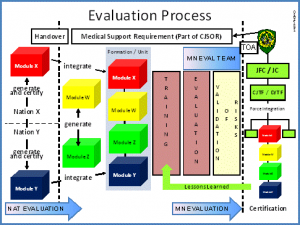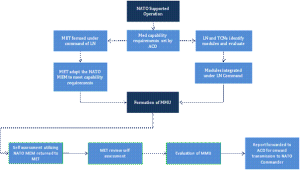
Article: L. FAZEKAS
Multinational approach in medical support to NATO operations
Evaluation challenges in deployments of multinational medical units
National and NATO medical staff responsible for deployment of Multinational Medical Units (MMU) face multiple challenges due to differences
in national medical standards, quality of care medical training and education. The recently developed AMedP-27 RD1, Medical Evaluation
Manual (MEM) serves as a tool for evaluation of MMUs both at national and NATO levels. It clearly states procedures, methods, grading and
standards against which the MMUs are evaluated. Supporting the AMedP-27 RD1 ratification is highly recommended to all nations in order
to achieve an agreed set of military medical standards that serves as reference level for actual and future deployments. The MILMED COE is
developing a new course in order to train military medical staff to become qualified MMU evaluators.
Reasons for deployment of Multinational Medical Units
The typical medical support principle of cold war era was the simple “national responsibility” approach when the medical assets were provided to forces by their own nations. It required little co-operation among national medical units assigned to forces. Numerous changes in military conditions of post cold war era mainly the reduction in military budgets, manpower (including medical), the NATO expansion, transformation and new ambitions led to increased need for multinational medical solutions, because most of the nations are not able to provide a sustainable and cost-effective medical support to their deployed forces by their own. As a result, more and more Multinational Medical Units (MMU) have been deployed to NATO military operations worldwide since the mid 90s Balkan conflicts.
Possible evaluation concepts utilized in NATO
Ideally, it represents more professionalism and cost effectiveness at the same time if the deployed medical personnel is trained and equipped according to the same standards. Such ideal cases rarely happen without time consuming planning and preparations in order to harmonize national standards, equipment, training and language. Nowadays, the most attractive form of the MMU setting up is the utilization of the so called “Lead Nation (LN)” concept. In such cases one nation (LN)-that has the opportunity and the required background (technical, financial)-provides the framework of a medical facility or some modules and a limited personnel and other nations (Troop Contributing Nations (TCN)) provide personnel or a module. Before the deployment and Transfer of Authority (TOA) to the respective NATO Commander the MMU needs to be trained, certified, evaluated and integrated. The evaluation ought to be performed at different levels (detailed later) based on two concepts.
The first concept is the more time consuming when the LN and the TCNs conclude an agreement in the form of either a Memorandum of Understanding (MOU) or a Technical Arrangement (TA). The working language, training, education and skill standards generally form an integral part of the agreement. This administrative process is repeated for every newly formulated MMU beginning with the agreement talks, setting of standards, etc.
The second concept makes use of already agreed on standards and a specific evaluation process for unit integration. This concept has certain advantages because it reduces the time necessary to reach the Fully Operationally Capable (FOC) status, decreases the length of negotiations leading to an agreement between LN and TCN(s) and is simply more transparent. It also allows nations to develop new medical capabilities (ROLEs or modules) and design them in standardized way to ensure their interoperability in NATO operations from the beginning of the planning process.
Medical Evaluation Manual – the evaluation tool
 Figure 1 MMU Evaluation process
Figure 1 MMU Evaluation process
Two years ago the Committee of the Chiefs of Military Medical Services in NATO (COMEDS) came to the agreement to use the second concept in order to rely on defined standards for MMUs and to ensure minimum quality requirements to be met during deployed military medical support. COMEDS tasked its subordinated structure to develop a tool to evaluate, validate and certify multinational or national medical capabilities deployed to NATO operations. The outcome of the Expert Panels (EP) and Working Groups (WG) common work is the AMedP-27 Medical Evaluation Manual (MEM) with the covering STANAG 2560. The aim of this manual is to “facilitate and provide the framework for nations to certify their own medical capabilities and also for the medical evaluation of multinational medical modules and units, when formed to support NATO operations. Medical certification in the military field is the official recognition that a staff, module, unit or force component can provide the defined capability agreed by nations or, if it cannot, documents the residual risk and required mitigation." (AMedP-27, page 1-3)
As already mentioned in most cases many nations prefer to contribute modules or individuals to a multinational medical capability and the LN will integrate these modules into a multinational medical force. The evaluation procedure has to confirm the quality of care provided by this integrated medical force, but also has to focus on the shortfalls in order to allow a sound risk assessment regarding the medical support to the NATO troops. The evaluation process prior to deployment will be performed by a Multinational Evaluation Team (MET) which will be formed by qualified subject matter experts from NATO Command Structure, LN and from the TCNs. Upon TOA the NATO Commander can validate the quality of care of the medical forces and consider this an essential factor for operational readiness. The procedure allows the evaluation of medical capabilities which will be deployed as a part of the Combined Joint Task Force (CJTF) or under a command and control of a Deployable Joint Task Force (DJTF) in a NATO Response Force (NRF) operation. For both options NATO will set the requirements for supporting medical capabilities within the Combined Joint Statement of Requirements (CJSOR) that serve as a strategic matrix of necessary deployable capabilities.
Though the evaluation procedure described in the manual focuses on the two previously cited types of operations (CJTF/DJTF) it is also recommended for any type of NATO and even non NATO operations.
The MEM main body describes and defines the evaluation process, levels, evaluation teams and procedures while the set of standards against which the unit is graded is described in annexes, which later can be released in a format of different STANAGs. Therefore it will be possible to adopt the standards according to latest scientific developments without changing the procedure in principle. As a standalone document it includes basic support references and allows the user to select only the relevant sections in order to meet the requirements of the mission related medical capabilities. The MEM also emphasizes that effective multinational medical support can only be achieved through effective training on a solid basis of multinational interoperability.
The Military Medical Training Expert Panel (MMT EP) has been responsible for the development of the evaluation procedure, the capability standards called “Capability matrix” were developed by the Military Medical Structures, Operations and Procedures Working Group (MMSOP WG) and the individual qualifications and requirements stated in the “Skill Set matrix” were identified by the Military Health Care Working Group (MHC WG).
The Medical Evaluation Manual (AmedP-27) reached the ratification draft status at 2009. Due to actual shortfalls concerning MMUs it is highly recommended to ratify the document as soon as possible. The evaluation procedure itself is based on key questions and supporting questions, all types of questions are related to personnel, equipment or procedures. Each of the modules or the capabilities will be evaluated by posing a key question aiming at the overall capability of the module. The supporting questions focus at the sub-capabilities and performances which form the capability set as an entity. All key and supporting questions should be answered in a valid way in order to guarantee full risk identification and timely recommendations for mitigating the capability gaps.
 Figure 2 Evaluation process for a Multinational Medical Unit
Figure 2 Evaluation process for a Multinational Medical Unit
Regarding to the procedure the evaluation takes place at different levels like individual, module, unit and finally the whole operation`s medical support system levels. The individual level deals with the representations of skills and its sets among the medical personnel. The module level evaluation is a national responsibility and used to evaluate the contributed part of the Multinational Medical Force. The third level, the unit level, deals with the entire MMU and evaluated by the Multinational Evaluation Team under the responsibility of the Lead Nation. At the Medical Support System evaluation level the whole medical support system is validated during a joint exercise under the responsibility of the Joint Force Commander.
The outcome of the evaluation categorizes the quality of a medical capability and provides a risk assessment using a three level grading system. The following categories will be applied: Fully Capable/No risks identified; Capable/Minor risks identified; Capable with limitations/Major risks identified.
NATO MILMED COE – NATO MEM Evaluator Course
As previously mentioned the evaluation process will be performed by a Multinational Evaluation Team MET). All MET members need to undertake and complete an implementation training to ensure validity, credibility and consistency in application of the NATO MEM tool. In this concern the NATO Centre of Excellence for Military Medicine (NATO MILMED COE) is linked to the MEM and to the Evaluation process itself. The NATO MILMED COE included the development of the NATO MEM Evaluator course where the potential evaluation team member will be trained on the application of the manual to its 2010 Programme of Work. The course is going to be a NATO accredited course and the NATO MILMED COE has already initiated the start of the accreditation process with Allied Command Transformation (ACT) according to respective regulations. The first pilot course is planned in Budapest, Hungary during 21-25 June 2010. The target audience has been identified as medical staff responsible for training, evaluation, validation and certification of deployable national / multinational medical units from the NATO Command Structure, NATO Force Structure, NATO nations and other nations as well as medical personnel appointed for deployments to NATO HQs of operations.
Date: 03/28/2018











